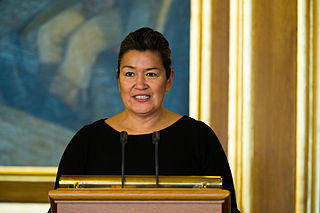The politics of Greenland, a "constituent country" of the Kingdom of Denmark, function in a framework of a parliamentary representative democratic dependency, whereby the prime minister is the head of government, and of a multi-party system. Executive power is exercised by the government. Legislative power is vested in both the government and parliament Inatsisartut. The judiciary is independent of the executive and the legislature. Greenland has full autonomy on most matters, except on policies and decisions affecting the region including negotiations with the devolved legislatures and the Folketing.

The flag of Greenland was designed by Greenland native Thue Christiansen. It features two equal horizontal bands of white (top) and red with a large disk slightly to the hoist side of centre. The top half of the disk is red, the bottom half is white. The entire flag measures 18 by 12 parts; each stripe measures 6 parts; the disk is 8 parts in diametre, horizontally offset by 7 parts from the hoist to the centre of the circle, and vertically centered.

Nuuk is the capital and largest city of Greenland. It is the seat of government and the country's largest cultural and economic centre. The major cities closest to the capital are Iqaluit and St. John's in Canada and Reykjavík in Iceland. Nuuk contains almost a third of Greenland's population and its tallest building. Nuuk is also the seat of government for the Sermersooq municipality. In January 2019, it had a population of 17,984.

The term "the unity of the Realm" refers to the relationship between Denmark proper, the Faroe Islands and Greenland—three countries constituting the Kingdom of Denmark.
A non-binding referendum on Greenland's autonomy was held on 25 November 2008. It was passed with 75% approval and a 72% turnout. The referendum was announced by Prime Minister Hans Enoksen on 2 January 2008. Enoksen also announced the launch of an information and discussion campaign on the issue of self-government. This included town hall meetings throughout the country.

The following is an alphabetical list of topics related to the nation of Kalaallit Nunaat (Greenland).

The Greenlandic Inuit are the indigenous peoples and the most populous ethnic group in Greenland. Most speak Greenlandic and consider themselves ethnically Greenlandic. People of Greenland are citizens of Denmark.

Dr. Hinrich Johannes Rink was a Danish geologist, one of the pioneers of glaciology, and the first accurate describer of the inland ice of Greenland. Rink, who first came to Greenland in 1848, spent 16 winters and 22 summers in the Arctic region, and became notable for Greenland's development. Becoming a Greenlandic scholar and administrator, he served as Royal Inspector of South Greenland and went on to become Director of the Royal Greenland Trading Department. With "Forstanderskaber", Rink introduced the first steps towards Greelandic home rule.

Greenlandic independence is a political ambition of some political parties, advocacy groups, and individuals of Greenland, an autonomous country of the Kingdom of Denmark, to become an independent sovereign state.

Aleqa Hammond is a Greenlandic politician and member of the Danish Folketing (parliament). Formerly the leader of the Siumut party, she became Greenland's first female Prime Minister after her party emerged as the largest parliamentary faction in the 2013 elections. In 2014 she stepped down as Prime Minister and leader of Siumut, following a case of misuse of public funds. She was expelled from Siumut on 23 August 2016 after yet another case of misuse of public funds and became an independent. On 31 March 2018 she announced that she is running in the 2018 Greenlandic parliamentary election for the Siumut breakaway Nunatta Qitornai.

Atassut is a liberal-conservative and unionist political party in Greenland. Founded on 29 April 1978, Atassut is an established partner of the Liberal Party of Denmark.
LGBT Qaamaneq – Landsforeningen for Bøsser, Lesbiske, Biseksuelle og Transpersoner i Grønland is a lobby group for gay, lesbian, bisexual and transgender people in Greenland.
Augustinus "Augo" Telef Nis Lynge was a Greenlandic politician, educator, poet and writer who was the first Greenlandic representative in the Danish parliament and died during the sinking of the MS Hans Hedtoft.
Finn Lynge was a Greenlandic politician, Indigenous rights activist, priest and civil servant who from 1979 until 1984 was the sole Member of the European Parliament for Greenland. Lynge campaigned for Greenland withdrawal and his seat was abolished when Greenland withdrew from the European Communities.
Kristoffer Lynge (1894-1967) was a Greenlandic journalist, writer and politician.













